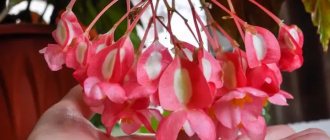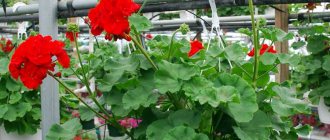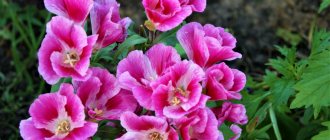Bright begonia bushes can turn any place into a piece of paradise, be it a window sill, balcony, veranda or flower bed in the garden. However, lush flowering takes a lot of energy from plants, and in winter they need a long rest. The most capricious in this regard are the tuberous varieties, which need to organize a comfortable dormant period, otherwise they will not form flower buds for the next season. This article will tell you how to preserve begonia until spring, so that next year it will again delight others with its exotic colors.
Why can't begonias be left outside in winter?
According to scientists, there are more than 1 thousand species of begonias in nature. Almost all of them live in tropical and subequatorial forests of Africa and South America, as well as on the islands and coasts of the Indian Ocean. As representatives of a warm and fairly humid climate, in our latitudes these flowers prefer indoor conditions and do not tolerate even the slightest frost.
56967.jpg
However, there are species adapted to relative cold - tuberous begonias. They were originally discovered in the Andes (Peru, Bolivia) in the 60s of the 19th century, and subsequently became the basis for the selection of many cultivated varieties. To survive in the mountains with cool winters, plants learned to accumulate moisture and microelements in thickened roots - tubers, which made their flowers even larger than those of their tropical relatives that bloom all year round. But it should be noted that the temperature in the Southern Andes never drops below +3°C, and in the harshest months it stays at +7...10°C. In summer, the mountain belt also does not warm up much - only up to +15...20°C, and besides, it often drizzles and fogs there.
begonia_walsall_485151_1920x1200.jpg
Methods and conditions
There are only three ways to store begonia tubers:
If begonia tubers are stored in the basement, wait until they are completely dry . Only after this they are placed in plastic boxes/cardboard boxes. After sifting the sand, pour it on top. You can prepare another soil mixture to protect planting material from rotting: sand, peat and sawdust. This method is chosen when a lot of tubers are saved. The basement should not be damp so that they do not rot.- Another storage method is in an apartment . It is advisable to allocate a place for the tuber material under the door to the balcony or window in the coldest room. If they put it in a box, then sawdust and sand must be sprinkled on top. In the apartment, in a flower pot suspended from the ceiling, begonias are kept, limiting watering and cutting off the stems almost completely.
- The third way is the refrigerator . It is good when there is little tuber material. In this case, put it in a plastic bag with sawdust and several holes for breathing. If they are not available, wrap each tuber separately in paper sheets. Only after this do they put the plastic bags in the refrigerator, in the compartment for vegetables and fruits.
We invite you to read interesting information about the propagation of begonias, including cuttings. In addition, it will be useful to read the article about planting this wonderful plant.
How to preserve ever-blooming begonia?
To choose the best way to preserve begonia at home, you must first determine its type and age. Thus, ever-flowering and decorative deciduous varieties remain overwintering on window sills or in greenhouses, where they are provided with warmth within +18...25°C, good lighting, regular watering and air humidification with heated water from a sprayer.
1468727322_img_4771.jpg
Almost the same care should be provided for young specimens of tuberous begonias grown from seeds or cuttings. The reason is that before reaching 2-3 years, tender sprouts do not have time to form a tuber, and any attempt to remove them from the ground, accidental damage to the roots or drying out of the above-ground part leads to the death of the flower.
5cc6e405e327c5cc6e405e32b9.jpg
Preparation for storage
Before winter storage, tuberous begonias need to be dried. Garden ones are first dug up, and home ones are taken out of the pot. After this, the stem is cut, leaving a small stalk.
The tubers are dried for about two weeks at room temperature. The soil remaining on them should dry out, and the rest of the stem should easily separate. After removing the dry one, inspect the planting material. Small affected areas are cut off and smeared with brilliant green or sprinkled with crushed coal.
How to preserve tuberous begonia until spring?
Since tuberous species easily adapt to different weather conditions, they are often grown outdoors - in open flowerpots, hanging flowerpots, and sometimes just in the ground. But as soon as there is a threat of frost, these flowers should be removed indoors. The transition of begonias to a state of winter dormancy is gradual and consists of several stages:
1) Autumn cessation of watering. About a month before the temperature is expected to drop below 0°C (depending on the region, this could be August, September or even October), begonias need to create a drought by first reducing watering to once a week, and then completely stopping soil irrigation. As a result, the bushes will begin to prepare for sleep, which will manifest itself in the drying out of their ground parts.
However, this procedure is only suitable for adult plants with tubers at least 3 cm thick. It is recommended to moisten young ones regularly, and as soon as the thermometers drop below +10...12°C, move them indoors to a bright windowsill.
begonija-sohnet.jpg
2) Collection and drying. When the foliage and flower stalks wither, the begonia must be carefully removed from the soil, shaken off the remaining soil, remove dead wood and thin roots, leaving only the tubers themselves. If they are dirty, infested with insects or larvae, it is worth washing the planting material with a light pink solution of potassium permanganate in warm water, treating it with insecticides, and cutting off the rotten areas and sprinkling them with crushed charcoal powder. After this, the tubers should be left for 2-3 weeks in a cool, dry place to dry.
27-16.jpg
3) Storing begonias in winter. Throughout the cold season, clean, dried tubers should be in a kind of “hibernation.” To do this, they require a temperature of +7...10°C (in no case higher) and a humidity of 60-70%. Each gardener decides where and how to store begonia in the winter in an apartment in his own way: someone wraps each tuber in newsprint, sprays it with a spray bottle, places it in a plastic bag and keeps it in the vegetable compartment of the refrigerator; someone puts them in containers with damp sawdust, sand or sphagnum moss, and then puts them in the basement or pantry. The main thing is to choose a dark, unheated room, and also to ensure that the planting material does not freeze and never remains completely dry.
4-2.jpg
4) Awakening of tubers. Approximately 4-6 weeks before the start of spring work, in February or early March, planting material is prepared. This is done not only to speed up the growing season, but also to understand which side to bury the tubers in the ground. In a “dormant” state, it is not visible from them where future shoots will appear, and due to improper placement, the buds may simply not break through and die in the ground.
begoniya-ampelnaya-kakoj-ona-byvaet-i-kak-uhazhivat-za-nej-v-domashnih-usloviyah-35.jpg
The awakening process is as follows: peat (sand, sawdust, ordinary soil) is poured into a wide pot or container, moistened abundantly, dry tubers are laid out on top without any depression, all this is left at a temperature not lower than +18...20°C in a sunlit place, and sprayed daily with warm water. At night, the structure can be covered with glass or film to maintain a kind of greenhouse effect and speed up the awakening process.
image.jpg
5) Planting tuberous begonias. Emerging white or greenish shoots are a sure signal that it’s time to plant future flowers in the ground. It is advisable to cut large tubers with several “eyes” into pieces, like potatoes, but the fragments should be at least 3 cm thick. The sections are sprinkled with powdered coal or ash. This procedure rejuvenates the plants, thereby significantly increasing their decorative qualities.
It is recommended to choose the volume of containers for begonias in accordance with the size of the tubers: 0.5 liters will be enough for small specimens, up to 3 liters for large specimens. Drainage from pebbles or expanded clay should be poured into the bottom of the pot, then a mixture for indoor plants or nutritious garden soil with the addition of 30-40% humus or peat, 10% sand and 10% perlite, vermiculite or hydrogel beads to retain moisture.
b252ba70.jpg
The tuber should be positioned so that the broken bud is on top. The thickened roots of the begonia are filled to a depth of only 1-2 cm, after which they are regularly watered, preventing the earthen coma from drying out. As soon as the first leaf appears, it is necessary to provide the begonia with slightly diffused sunlight. A south or southwest window shaded with translucent tulle is ideal for this.
vyraschivanie_begonii_iz_klubnya_v_domashnih_usloviyah_po_sovetam_cvetovodov_video_1-4.jpg
After warm spring weather without frost has established, the flower can be transferred to the open air and enjoy the riot of exotic colors, not forgetting to moisten the soil in time and periodically apply complex mineral fertilizers for this group of plants.
Features of winter care
Begonia is a plant that constantly grows, with virtually no period of absolute dormancy. Favorable external conditions are important for a flower to “feel” good in winter. An indicator of such well-being is the bright color of its leaves. If the color of the foliage changes, this indicates that the plant is getting sick.
Begonia tolerates wintering quite well. The flower overwinters without any negative consequences only if it is properly cared for. So, in order for begonia to grow well, certain microclimate parameters must be maintained in the room where it is located. Temperature conditions in winter are important for begonias. During the cold season of the year, the plant does not require high temperatures. Experts recommend changing the temperature slightly. This will keep the plant in good condition.
During the winter period, you should also monitor the regularity of watering. Begonia needs moisture. However, overwatering can cause the plant to develop fungal diseases.
Another important indicator to monitor is humidity. Due to the fact that heating devices operate indoors in winter, this microclimate indicator changes. So, too dry air in the apartment can cause begonia leaves to lose their natural turgor. Plant care experts recommend moving this ornamental plant away from a heating device (for example, a radiator) in winter. This will help reduce the risk of developing possible leaf damage.
Is it necessary to dig during cold weather?
Begonia is a heat-loving plant .
In the wild, it grows in countries where the climate is hot. Thanks to selection work, the beauty is grown in the garden and on windowsills by flower growers from Russia. In order for it to survive the winter, do not cut off the foliage in the first days of summer and do not dig up the tubers before serious frosts. Autumn is an important stage in the life of a plant. It is at this time that it grows tubers, storing nutrients in them and forming buds for flower stalks that will bloom next year. Therefore, there is no need to rush to organize hibernation, but there is no need for delay either.
TIP : Tubers are always dug up for the winter if the crop is growing in the garden. After drying, store them in paper bags in the refrigerator. Neglecting this procedure, one is not surprised at the death of garden begonia over the winter.











